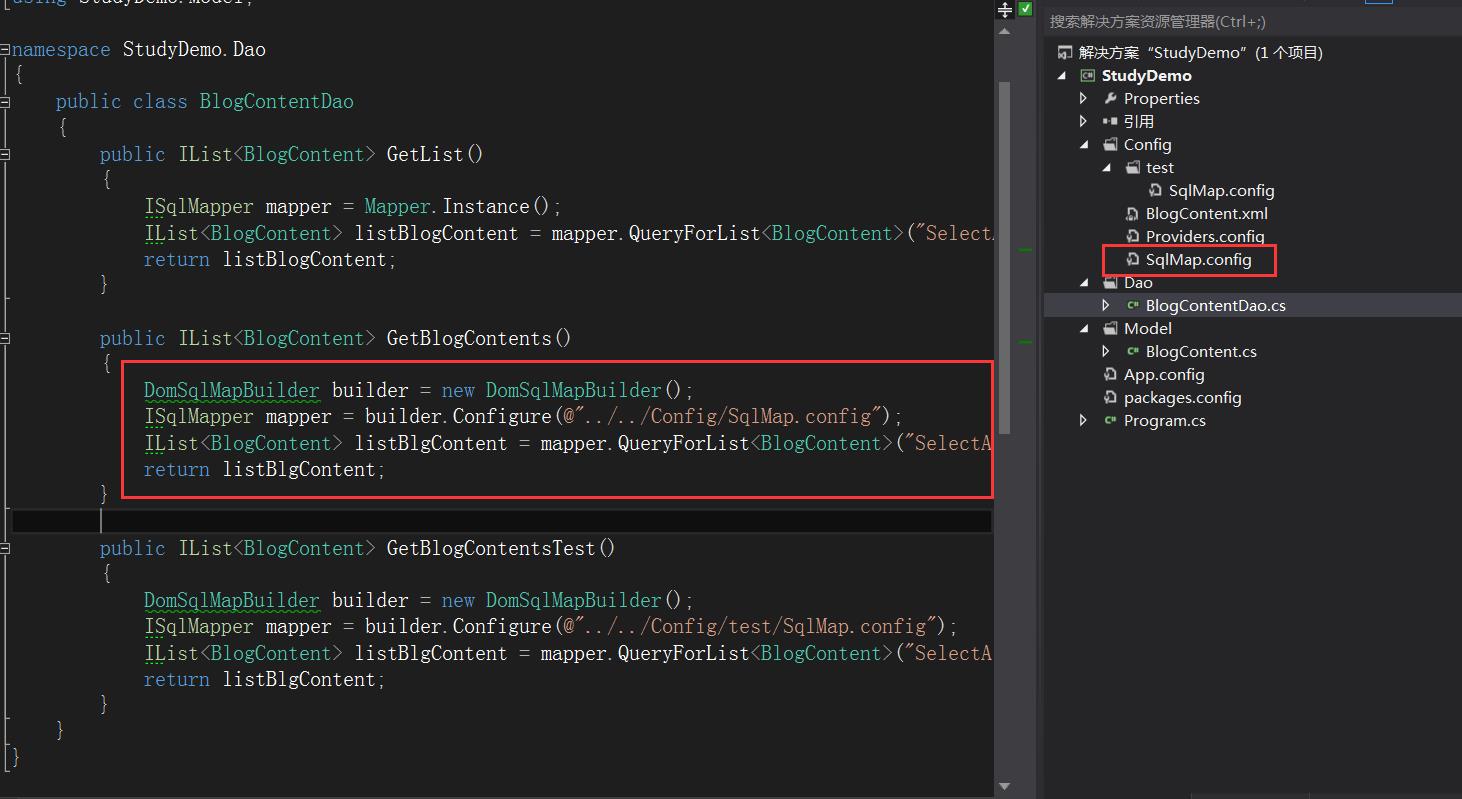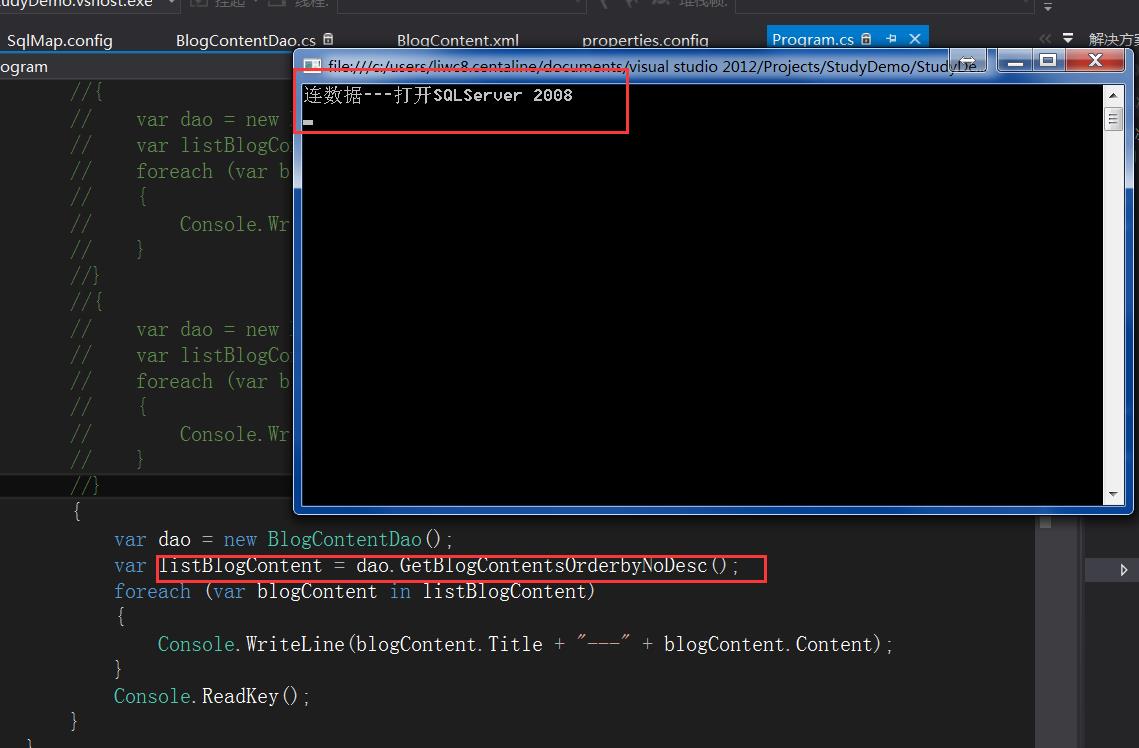Ibatis学习2 ---配置文件学习
Posted Soft Steven
tags:
篇首语:本文由小常识网(cha138.com)小编为大家整理,主要介绍了Ibatis学习2 ---配置文件学习相关的知识,希望对你有一定的参考价值。
1、Ibatis.Net 主要用到三个配置SqlMap.config Providers.config XXXX.xml
SqlMap.config 主要用于配置数据库连接、缓存控制类等信息。
providers.config 主要用于指定数据库
xxxxx.xml 主要用于设置映射规则
2、不指定配置文件的位置 配置文件应该放置在默认的位置
Windows应用项目或者类库项目,需要放在项目的bin/debug目录下
在Web应用程序中,需要放在应用程序根目录
在初始化数据库连接的时候 可以通过DomSqlMapBuilder 来指定具体的SqlMap文件放置的位置
首先,需要初始化一个类 var builder=new DomSqlMapBuilder();
通过DomSqlMapBuilder的Configure指定具体的SqlMap.config 放置的路径 。 虽然我们指定了读取SqlMap.config的路径 其中配置的xxx.xml 及数据库的支持文件Providers.config还是要在默认的位置来找


using System.Collections.Generic; using IBatisNet.DataMapper; using IBatisNet.DataMapper.Configuration; using StudyDemo.Model; namespace StudyDemo.Dao { public class BlogContentDao { public IList<BlogContent> GetList() { ISqlMapper mapper = Mapper.Instance(); IList<BlogContent> listBlogContent = mapper.QueryForList<BlogContent>("SelectAllBlogContenty", null); return listBlogContent; } public IList<BlogContent> GetBlogContents() { DomSqlMapBuilder builder = new DomSqlMapBuilder(); ISqlMapper mapper = builder.Configure(@"../../Config/SqlMap.config"); IList<BlogContent> listBlgContent = mapper.QueryForList<BlogContent>("SelectAllBlogContenty", null); return listBlgContent; } public IList<BlogContent> GetBlogContentsTest() { DomSqlMapBuilder builder = new DomSqlMapBuilder(); ISqlMapper mapper = builder.Configure(@"../../Config/test/SqlMap.config"); IList<BlogContent> listBlgContent = mapper.QueryForList<BlogContent>("SelectAllBlogContenty", null); return listBlgContent; } } }
3、SqlMap.config配置文件中的节点学习
创建一个新的属性键值对的配置文件properties.config内容如下
<?xml version="1.0" encoding="utf-8" ?> <settiing> <add key="datasource" value="server=GSHC-LIWC8;uid=sa; pwd=111111;database=MVC5"/> </settiing>

首先我们看一个完整的SqlMap.config文件 我们看上面的这个文件中的第一个Properties节点,可以引用外部的定义的键值对数据的内容供后面统一使用。
上面的这些键值对配置文件的引入可以通过三种方式来引入
resource :相对路径引入
url:通过绝对路径来确定文件位置
embedded: 通过嵌入资源方式来确定文件的位置
<?xml version="1.0" encoding="utf-8"?> <sqlMapConfig xmlns="http://ibatis.apache.org/dataMapper" xmlns:xsi="http://www.w3.org/2001/XMLSchema-instance"> <properties resource="../../config/properties.config"/> <settings> <setting useStatementNamespaces="false"/> </settings> <providers resource="../../config/providers.config"/> <database> <provider name="sqlServer2008"/> <dataSource name="test" connectionString="${datasource}"/> </database> <sqlMaps> <sqlMap resource="../../config/BlogContent.xml"/> </sqlMaps> </sqlMapConfig>
Settings节点
Settings节点里,可以配置以下5个信息
- useStatementNameSpaces 默认False 是否使用全局完整的命名空间
- cacheModelsEnabled 默认true 是否启用缓存
- validateSqlMap:默认false,使用启用SqlMapConfig.xsd来验证映射XML文件。
- useReflectionOptimizer:默认true,是否使用反射机制访问C#中对象的属性。
- useEmbedStatementParams 是否使用嵌入的方式声明可变参数
Providers节点
示例:
<providers resource="providers.config"/>
这里使用引入外部配置文件的方式实现。
alias节点
alias节点用于为类指定一个别名,通常用于为一些很长的类名指定一个别名,这样可以减少一些代码。
<typeAlias alias="Person" type="iBatis.Domain.Person,iBatisSample"/>
以上代码的意思是,为iBatis.Domain.Person类指定一个别名Person。Person就代表iBatis.Domain.Person这个类。
起初我以为别名只是起了缩短配置类的作用,但后来我发现别名是还有其他作用的,它还指明了IBatis.net应该到哪个程序集去找实体类。
如果程序偶尔报如下错误,那么你就要考虑加上别名了。
“/”应用程序中的服务器错误。
Could not load type from string value \'xxx\'
<alias> <typeAlias alias="Field" type="Nx.Domain.Common.Field, Nx.Domain" /> </alias>
database节点
指定一个你选择使用的数据库,和数据库连接。
示例:
<database>
<provider name="sqlServer2008"/>
<dataSource name="Test" connectionString="server=KISSDODOG-PC;uid=sa;pwd=123;database=Test"/>
</database>
SqlMaps节点
SqlMaps节点,用于配置映射信息。通常在映射信息写在外部,在这个节点引入。
映射文件的学习
Model下定义一个新的实体类Blog
namespace StudyDemo.Model { public class Blog { public int Id { get; set; } public string No { get; set; } public string Title { get; set; } public string Content { get; set; } } }
新建一个BlogContent.xml的映射文件 内容如下
<?xml version="1.0" encoding="utf-8" ?> <sqlMap namespace="Ibatis" xmlns="http://ibatis.apache.org/mapping" xmlns:xls="http://www.w3.org/2001/XMLSchema-instance"> <resultMaps> <resultMap id="blogcontent" Class="StudyDemo.Model.Blog"> <result property="Id" column="Id" /> <result property="No" column="TestNo"/> <result property="Title" column="TestTitle"/> <result property="Content" column="TestContent"/> </resultMap> </resultMaps> <statements> <select id="selectAllBlog" resultMap="blogcontent"> select * from blogcontent </select> </statements> </sqlMap>
resultMaps部分:定义了数据库字段名与实体类属性名之间的关系。当然,如果你数据库字段名与实体类属性名完全一样,那么resultMaps部分是可以省略的。另外要注意一点,ResultMap的列比你查询的列不能少,也不能多。它不会说,ResultMap里映射的列多了,该属性就自动将select返回的列自动置null,而是直接所有列都不映射赋值。也就是说,Person表有Id,Name,Age3列,如果你只想要SELECT两个列(Id,Name),那么ResultMap里面的3列映射没用了,你必须另外搞一个ResulpMap只映射两列的。不爽。
statements部分:用于定义你需要执行的语句,在程序中通过select的id调用。
加入以下方法,执行查看结果正常情况是可以正常显示
public IList<Blog> GetBlogContentsTest() { DomSqlMapBuilder builder = new DomSqlMapBuilder(); ISqlMapper mapper = builder.Configure(@"../../Config/test/SqlMap.config"); IList<Blog> listBlgContent = mapper.QueryForList<Blog>("selectAllBlog", null); return listBlgContent; }
|
属性 |
说明 |
|
parameterMap |
参数映射,需结合parameterMap节点对映射关系加以定义,对于存储过程之外的statement而言,建议使用parameterClass作为参数配置方式,一方面避免了参数映射配置工作,另一方面其性能表现更加出色 |
|
parameterClass |
参数类。指定了参数类型的完整类名(包括命名空间),可以通过别名避免每次书写冗长的类名 |
|
resultMap |
结果映射,需结合resultMap节点对映射关系加以定义 |
|
resultClass |
结果类。指定了结果类型的完整类名(包括命名空间),可以通过别名避免每次书写冗长的类名 |
|
cacheModel |
Statement对应的Cache模块 |
|
extends |
重复使用SQL子句
|
映射文件中extends使用
修改映射文件如下
<?xml version="1.0" encoding="utf-8" ?> <sqlMap namespace="Ibatis" xmlns="http://ibatis.apache.org/mapping" xmlns:xls="http://www.w3.org/2001/XMLSchema-instance"> <resultMaps> <resultMap id="blogcontent" Class="StudyDemo.Model.Blog"> <result property="Id" column="Id" /> <result property="No" column="TestNo"/> <result property="Title" column="TestTitle"/> <result property="Content" column="TestContent"/> </resultMap> </resultMaps> <statements> <select id="selectAllBlog" resultMap="blogcontent"> select * from blogcontent </select> <select id="selectAllBlogOrderbyNodesc" resultMap="blogcontent" extends="selectAllBlog"> order by TestNo desc </select> </statements> </sqlMap>
增加新的方法:
public IList<Blog> GetBlogContentsOrderbyNoDesc() { DomSqlMapBuilder builder = new DomSqlMapBuilder(); ISqlMapper mapper = builder.Configure(@"../../Config/test/SqlMap.config"); IList<Blog> listBlgContent = mapper.QueryForList<Blog>("selectAllBlogOrderbyNodesc", null); return listBlgContent; }
执行代码调用方法测试,正常情况将会根据TestNo进行倒排。
parameterClass 使用示例
修改映射文件为
<?xml version="1.0" encoding="utf-8" ?> <sqlMap namespace="Ibatis" xmlns="http://ibatis.apache.org/mapping" xmlns:xls="http://www.w3.org/2001/XMLSchema-instance"> <resultMaps> <resultMap id="blogcontent" Class="StudyDemo.Model.Blog"> <result property="Id" column="Id" /> <result property="No" column="TestNo"/> <result property="Title" column="TestTitle"/> <result property="Content" column="TestContent"/> </resultMap> </resultMaps> <statements> <select id="selectAllBlog" resultMap="blogcontent"> select * from blogcontent </select> <select id="selectAllBlogOrderbyNodesc" resultMap="blogcontent" parameterClass="StudyDemo.Model.Blog" extends="selectAllBlog"> where TestNo =#No# order by TestNo desc </select> </statements> </sqlMap>
增加新方法
public IList<Blog> GetBlogContentsOrderbyNoDesc() { DomSqlMapBuilder builder = new DomSqlMapBuilder(); ISqlMapper mapper = builder.Configure(@"../../Config/test/SqlMap.config"); Blog t=new Blog(){No = "01"}; IList<Blog> listBlgContent = mapper.QueryForList<Blog>("selectAllBlogOrderbyNodesc",t); return listBlgContent; }
执行的时候,正常结果如下
查询的时候根据传的参数 Blog t=new Blog(){No = "01"};进行了过滤

parameterMap的属性
它可以接受三个属性,id/class/extends,其中是有id是必须的,class用于声明使用的实体类名称,可以是别名,也可以是全名,extends,可想而知,不解释
在它下一级节点中应该包含若干个parameter元素,来指定对象属性与当前变量的映射规则,parameter有如下常用属性:
- property:指定类中的一个属性
- columu:定义的参数名称
- direction:用于声明存储过程的参数方向(input,output,inputoutput)
- dbType:用于指定property映射到数据库中的数据类型
- type:用于为参数的对象指定CLR类型
- nullValue:指定在property为何值时,将会在存储数据时候,替换为null,这是经常会被用到的
- size:用于指定最大值
这个指定的映射信息中Property column 是不起作用的,参数必须与需要的参数顺序一致
$与#的区别
- SELECT * FROM TABLE WHERE Id = #id# 其中如果字段id为字符串类型,那么#id#表示的就是\'id\',也就是说会自动加引号。如果id为整型,那么#id#就是整型;
- SELECT * FROM TABLE WHERE Id = $id$ ,如果字段id为整型,Sql语句就不会出错,但是如果字段id为字符串类型,那么Sql语句应该写成 SELECT * FROM TABLE WHERE Id = \'$id$\',否则会出错,因为它不会自动增加单引号。
以上是关于Ibatis学习2 ---配置文件学习的主要内容,如果未能解决你的问题,请参考以下文章
